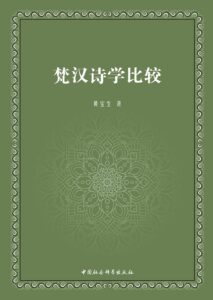
Huang Baosheng 黄宝生
Beijing: China Social Sciences Press 中国社会科学出版社, 2021.
Reviewed by Chen Yilan (PhD candidate of Peking University, HYI Visiting Fellow)
Huang Baosheng’s 2021 publication “A Comparative Study of Sanskrit and Chinese Poetics” (梵汉诗学比较) is a work of comparative research in ancient literary theories of China and India, representing the culmination of his years of translation and research in Sanskrit literature, Sanskrit poetics, and comparative poetics. The author published “Classical Indian Poetics” (印度古典诗学) in 1994, which focused on the study of classical Indian Sanskrit literary theory, followed by a translated compilation “Anthology of Sanskrit Poetics” (梵语诗学论著汇编) in 2005, and an expanded edition in 2019. Now this work aims to bridge the literary theories of different ethnicities through comparison, while also revealing the differences and reasons behind these various national literary theories.
The book establishes twelve literary theoretical propositions: 1) the origin, development, and forms of poetics; 2) the definition of literature; 3) genres; 4) dramaturgy; 5) rhetoric; 6) stylistics; 7) aesthetic flavor; 8) rhyme; 9) the function of literature; 10) the author; 11) the reader; 12) imitation and innovation. It compares each of these elements and their manifestations in ancient Indian and Chinese literary theories. As this book is primarily aimed at Chinese-speaking readers, and considering their relatively lesser familiarity with Indian poetics, the author has structured the comparison of each proposition in two parts. The first part focuses on the manifestation of the proposition in ancient Indian literary theory, while the second part compares it with the corresponding aspects of ancient Chinese literature. Through the comparison of Sanskrit and Chinese poetics, we can find that their theoretical expressions are distinctly different, but they are consistent in many aspects of literary principles.
This book also contains five appendices, including three on ‘Comparative Studies of Chinese and Indian Cultural Traditions’, which elaborate from the perspectives of “mythology and history,” “religion and rationality,” and “language and literature.” Additionally, there is an article titled “Under the Light of Sanskrit Poetics – Reading Feng Zhi’s the Collection of Sonnets,” which not only interprets Feng Zhi’s the Collection of Sonnets using Sanskrit principles but also uses the Collection of Sonnets to test the principles of Sanskrit poetics, thereby illustrating that the basic principles of literature, both ancient and modern, domestic and foreign, are the same.
